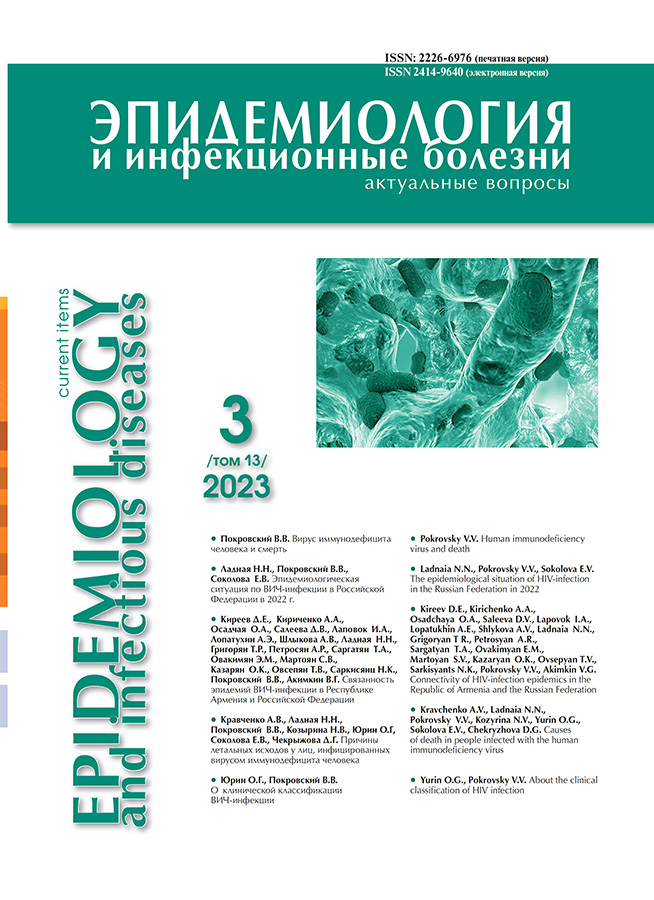Analysis of «emergency» situations among medical personnel in the Omsk Region
- 作者: Puzyryova L.V.1, Balabokhina M.V.2, Nazarova O.I.2, Magar N.I.2, Musin M.A.1, Tkachuk K.O.1
-
隶属关系:
- Omsk State Medical University, Ministry of Health of Russia
- Center for the Prevention and Control of AIDS and Infectious Diseases
- 期: 卷 13, 编号 3 (2023)
- 页面: 70-74
- 栏目: Original Investigations
- URL: https://journals.eco-vector.com/2226-6976/article/view/625330
- DOI: https://doi.org/10.18565/epidem.2023.13.3.70–4
- ID: 625330
如何引用文章
详细
Objective. Analysis of «emergency» situations among medical workers in the Omsk region for 12 years to identify the risks of occupational HIV infection.
Materials and methods. To collect data on «emergency» situations registered in the Omsk region in the period from 2001 to 2022, we used medical documentation provided by the regional AIDS center.
Results. 566 «emergency» cases were registered in 12 years among medical workers in medical institutions. The highest risk of HIV infection was observed among nurses (60.6%), followed by doctors and paramedical personnel. The most common injuries to the skin of medical personnel were caused by puncture, cut, scratching with piercing and cutting objects, which contained mainly the blood of patients (78.3%). In 11.0% of cases, blood got into the mucous membrane of the eyes, both among doctors and among nurses.
Conclusion. There is a high level of incidental exposure to blood and body fluids in daily routine medical activities.
全文:
作者简介
Larisa Puzyryova
Omsk State Medical University, Ministry of Health of Russia
Email: puzirevalv@mail.ru
ORCID iD: 0000-0003-0495-3645
МD, Associate Professor, Department of Phthisiology, Pulmonology and Infectious Diseases
俄罗斯联邦, OmskMaria Balabokhina
Center for the Prevention and Control of AIDS and Infectious Diseases
Email: mbalaboxina@mail.ru
ORCID iD: 0000-0001-5809-8053
Infectiologist, Нead, Outpatient Department № 2
俄罗斯联邦, OmskOlga Nazarova
Center for the Prevention and Control of AIDS and Infectious Diseases
Email: aids_mail@minzdrav.omskportal.ru
ORCID iD: 0000-0002-6271-7272
Cand. Med. Sci., Chief Physician
俄罗斯联邦, OmskNina Magar
Center for the Prevention and Control of AIDS and Infectious Diseases
Email: aids_mail@minzdrav.omskportal.ru
Epidemiologist, Head, Antiepidemic Department
俄罗斯联邦, OmskMakhmudh Musin
Omsk State Medical University, Ministry of Health of Russia
Email: mahmud.infek@gmail.com
ORCID iD: 0000-0003-2483-2189
Infectiologist, Teaching Assistant, Department of Phthisiology, Pulmonology and Infectious Diseases
俄罗斯联邦, OmskKonstantin Tkachuk
Omsk State Medical University, Ministry of Health of Russia
编辑信件的主要联系方式.
Email: werdum.f@mail.ru
ORCID iD: 0000-0001-8931-3895
Infectiologist, Senior Laboratory Assistant, Department of Phthisiology, Pulmonology and Infectious Diseases
俄罗斯联邦, Omsk参考
- Wyżgowski P., Rosiek A., Grzela T., Leksowski K. Occupational HIV risk for health care workers: risk factor and the risk of infection in the course of professional activities. Ther. Clin. Risk Manag. 2016; (12): 989–94. doi: 10.2147/TCRM.S104942.
- Дементьева Л.А., Липина Е.С., Ладная Н.Н. Риск инфицирования ВИЧ при оказании медицинской помощи. Инфекция и иммунитет 2017; (S): 769. Dement’eva L.A., Lipina E.S., Ladnaja N.N. [Risk of HIV infection while providing health care]. Russian Journal of Infection and Immunity 2017; (S): 769. (In Russ.).
- Подымова А.С., Голубкова А.А., Кукаркина В.А., Сисин Е.И. Риски профессионального заражения ВИЧ. Постконтактная профилактика (на примере Свердловской области). Эпидемиология и вакцинопрофилактика 2019; 18(3): 54–9. doi: 10.31631/2073-3046-2019-18-3-54-59. Podymova A.S., Golubkova A.A., Kukarkina V.A., Sisin E.I. [Risks of occupational HIV infection. Post-exposure prophylaxis (on the example of the Sverdlovsk region)]. Epidemiology and Vaccinal Prevention 2019; 18(3): 54–9. (In Russ.). doi: 10.31631/2073-3046-2019-18-3-54-59.
- О состоянии санитарно-эпидемиологического благополучия населения в Омской области в 2022 году. Государственный доклад. Управление Федеральной службы по надзору в сфере защиты прав потребителей и благополучия человека по Омской области, 2022. 229 с. [On the state of sanitary and epidemiological well-being of the population in the Omsk region in 2022. State report]. Office of the Federal Service for Supervision of Consumer Rights Protection and Human Welfare in the Omsk Region; 2022. 229 p. (In Russ.).
- ВИЧ-инфекция у взрослых. Клинические рекомендации. М.; 2022. 114 с. [HIV infection in adults. Clinical guidelines]. Moscow; 2022. 114 p. (In Russ.).
- Jahic R., Piljic D., Porobic-Jahic H., Custović A., Petrovic J., Piljic D. Epidemiological Characteristics of the Accidental Exposures to Blood-Borne Pathogens Among Workers in the Hospital. Med Arch. 2018; 72(3): 187–91. doi: 10.5455/medarh. 2018.72: 187-191.
- Obad I., Papeš D., Čivljak R., Milošević M., Stamenić V., Kalenić S. Assessment of professional exposure of gynecology employees in Croatia to bloodborne infections. Infectology papers 2012; 32(4): 159–66.
- Young T.N., Arens F.J., Kennedy G.E., Laurie J.W., Rutherford G.W. Antiretroviral post-exposure prophylaxis (PEP) for occupational HIV exposure. Cochrane Database Syst. Rev. 2007; (1): CD002835. doi: 10.1002/14651858.CD002835.pub3.
补充文件










